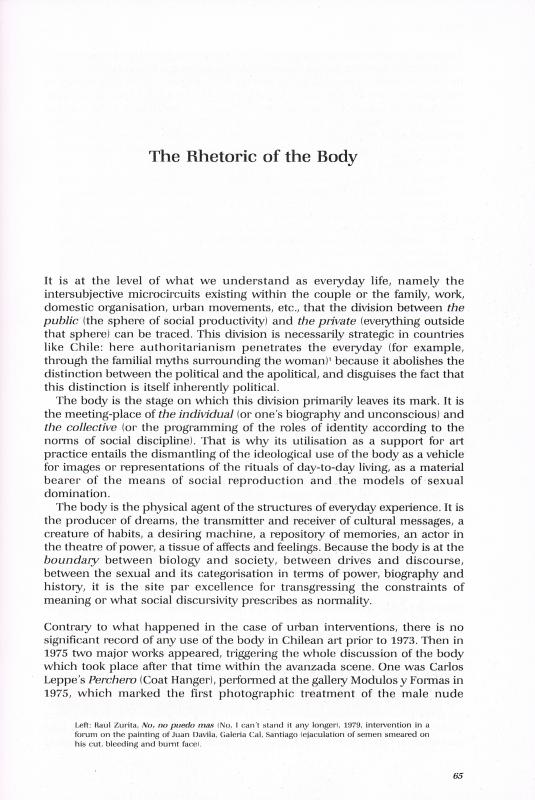The Cuatro artistas chilenos en el CAYC de Buenos Aires: Díaz, Dittborn, Jaar, Leppe exhibition was held at the CAYC (Centro de Arte y Comunicación) in Buenos Aires in 1985. The four participating artists were Gonzalo Díaz (b. 1947), Eugenio Dittborn (b. 1943), Alfredo Jaar (b. 1956), and Carlos Leppe (1952–2015). The exhibition was co-curated by the theorist and cultural critic Nelly Richard (b. 1948) and Jorge Glusberg (1932–2012), the founder and director of the CAYC. According to Richard, Leppe’s work was among the “leading lights of the new visual art scene in Chile.” She is referring to the art production that she called Escena de Avanzada, the “advanced scene” she identified in her 1986 book Margins and Institutions. Art in Chile Since 1973. This scene was known for generating a critical approach via semiotic works and the materials with which they were made, using aesthetics as a functional tool. [See in the ICAA Digital Archive: "Rhetoric of the body" (doc. no. 744815)].
Richard’s theoretical-affective relationship with Leppe began in 1977. At the time she was the director of Galería Cromo, in Santiago, where the artist exhibited Reconstitución de Escena, backed by a catalogue that included texts by Adriana Valdés (b. 1943), Cristián Hunneus (1935–1985), and Richard. In 1980 Richard published the book Cuerpo correccional [Correctional Body], which was edited by Francisco Zegers. This experimental publication relied on a rhetorical strategy that seemed to invite the reader’s involvement in an intimate dialogue between the theorist and the artist. By 1985 Richard had interpreted ten of the artist’s works that ran the gamut from physical actions to installations. The work presented at the CAYC exhibition, Proyecto de demolición de la cordillera de los Andes/Venta de materiales “pintura,” was, according to Richard, an “environment,” a concept developed by Allan Kaprow in the late 1950s. Leppe produced “environments” (or installations) on a regular basis, using a variety of elements ranging from organic matter to household objects, as shown at two exhibitions, Sala de Espera (1980) and María/Segundo “Pintura” (1983), both presented at the Galería Sur in Santiago.

